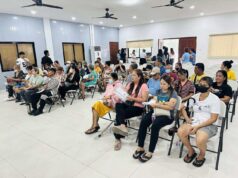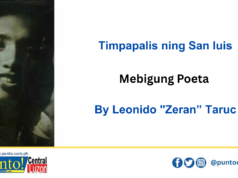IN APRIL 2009, the Clark Development Corp. beat the drums, clanged the cymbals and tooted the horn to welcome the birthing of “The Next Frontier.”
Spanning 10,674 hectares in the Sacobia sub-zone, the Next Frontier was bruited about as the Freeport’s second development area, specifically designated for education, tourism, agro-industrial and light manufacturing projects.
An initial P11.8 billion was projected to fund utilities and infrastructure over the next two years. So CDC President-CEO Benny Ricafort proudly announced then, breaking down the figure to P7.46 billion from private investors for power, water and telecommunications, and P3.72 billion for roads and bridges. With the proviso that investors may build the roads, with the cost deducted from their lease payments.
As added incentives, locators will enjoy tax holidays for four to six years.
The CDC, Ricafort lectured then, shall shell out an initial P150 million to be used for the construction of the first service area to be devoted to schools, commercial centers and social facilities including resettlement for the Aeta tribesmen in the area.
In terms of employment, the Next Frontier is expected to create 47,000 jobs.
Within days of the announcement of its birthing, a number of foreign and local investors trooped the line to Ricafort’s door, so the CDC press released.
Quick to the draw at every opportunity to append his name to anything remotely “developmental,” Rene Romero, president of the Pampanga Chamber of Commerce and Industry and chairman of the Advocacy for the Development of Central Luzon, did his own praise releasing of the project.
Crowed Romero: “Like the Clark Freeport Zone, the Next Frontier is the future of Pampanga and the rest of the Central Luzon region…Many residents and business groups are pinning their hopes on Clark, and the Next Frontier will assure future generations that Clark will not only be a catalyst of change but also the region’s vehicle to development and project.”
Taken by the brilliant promise of the Next Frontier, we joined the hallelujah chorus with our song of praise in this corner then:
And then, there is the Next Frontier, Clark Development Corp.’s new flagship development project to meet the growing demand of investors for more space at Clark, given the almost fully leased out land at the main Freeport. The cost of development: a staggering P11.18 billion.
The promise of the Next Frontier is brighter than bright – yeah, so bright you’ll need sunglasses, as the CDC operative phrase of some years back put it. There is a Taiwanese Donggwang investor for an economic zone in the area. An Orchids World, presumably some garden type, flower propagation enterprise; a tourism project by a firm called Grand Canyon; an area for the Philippine Tourism Authority project for the sport-of-the-moment, wake boarding; an industrial zone; and the Central Luzon campus of the Philippine Science High School.
Only to be as suddenly jolted back to my senses, thus a subsequent column:
The area identified in a so-called Clark Sub-zone master development plan is more than twice the size of the 4,400-hectare Clark Freeport but a mere fraction of the sub-zone’s total of 27,000 hectarage. So said a CDC factotum.
That, he continued, would readily cater to the “strong demand for land from both local and foreign businesses that plan on investing inside the Clark Freeport.”
CDC, it was emphasized, “wants to put premium in the pricing of land.”
So, sorry but I find something not totally right in CDC putting premium in pricing. It smacks of the antic of the unconscionable land “developer,” or the fly-by-night realtor that has neither conscience nor qualms over whatever happens to the land so long as he gets a premium price for it.
“Opening a frontier” also flashes in the mind the images of the slash-and-burn, mine-and-pollute, blast-dig-and-build despoilers of the land. These are the last people that the Clark Sub-zone needed. Their money, no matter how much, would be sorely short in paying for the degradation they cause.
Land use, not pricing, should be the premium here. Most especially since the Clark Sub-zone has both intrinsic natural and historical value.
For one, the Americans who served as stewards to the land in their near-century-long occupation of Clark had not simply recognized and proclaimed but protected it as a watershed, a wellspring of the most vital resource for the Freeport, the sub-zone and the contiguous communities including Angeles City.
The impact of development in the area therefore needs a study much, much deeper and extensive study than the issuance of the regulatory DENR impact assessment and environmental clearance certificates.
So we wrote then, and then, just as we feared, the Philippine Tourism Authority started scraping and digging the sides of mountains to hole-in its wakeboarding lake. It was the angry protests from the tribesmen and environmentalists, not any squeak from the CDC, that prevented what could have been an Ormoc incident there.
Still and all, it has been a year and seven months since its glorious birthing. So where are those promised investors – Donggwang, Orchids World, Grand Canyon, Philippine Tourism Authority, the Philippine Science High School?
Is the Sacobia project now reduced to a Nixed Frontier?
Spanning 10,674 hectares in the Sacobia sub-zone, the Next Frontier was bruited about as the Freeport’s second development area, specifically designated for education, tourism, agro-industrial and light manufacturing projects.
An initial P11.8 billion was projected to fund utilities and infrastructure over the next two years. So CDC President-CEO Benny Ricafort proudly announced then, breaking down the figure to P7.46 billion from private investors for power, water and telecommunications, and P3.72 billion for roads and bridges. With the proviso that investors may build the roads, with the cost deducted from their lease payments.
As added incentives, locators will enjoy tax holidays for four to six years.
The CDC, Ricafort lectured then, shall shell out an initial P150 million to be used for the construction of the first service area to be devoted to schools, commercial centers and social facilities including resettlement for the Aeta tribesmen in the area.
In terms of employment, the Next Frontier is expected to create 47,000 jobs.
Within days of the announcement of its birthing, a number of foreign and local investors trooped the line to Ricafort’s door, so the CDC press released.
Quick to the draw at every opportunity to append his name to anything remotely “developmental,” Rene Romero, president of the Pampanga Chamber of Commerce and Industry and chairman of the Advocacy for the Development of Central Luzon, did his own praise releasing of the project.
Crowed Romero: “Like the Clark Freeport Zone, the Next Frontier is the future of Pampanga and the rest of the Central Luzon region…Many residents and business groups are pinning their hopes on Clark, and the Next Frontier will assure future generations that Clark will not only be a catalyst of change but also the region’s vehicle to development and project.”
Taken by the brilliant promise of the Next Frontier, we joined the hallelujah chorus with our song of praise in this corner then:
And then, there is the Next Frontier, Clark Development Corp.’s new flagship development project to meet the growing demand of investors for more space at Clark, given the almost fully leased out land at the main Freeport. The cost of development: a staggering P11.18 billion.
The promise of the Next Frontier is brighter than bright – yeah, so bright you’ll need sunglasses, as the CDC operative phrase of some years back put it. There is a Taiwanese Donggwang investor for an economic zone in the area. An Orchids World, presumably some garden type, flower propagation enterprise; a tourism project by a firm called Grand Canyon; an area for the Philippine Tourism Authority project for the sport-of-the-moment, wake boarding; an industrial zone; and the Central Luzon campus of the Philippine Science High School.
Only to be as suddenly jolted back to my senses, thus a subsequent column:
The area identified in a so-called Clark Sub-zone master development plan is more than twice the size of the 4,400-hectare Clark Freeport but a mere fraction of the sub-zone’s total of 27,000 hectarage. So said a CDC factotum.
That, he continued, would readily cater to the “strong demand for land from both local and foreign businesses that plan on investing inside the Clark Freeport.”
CDC, it was emphasized, “wants to put premium in the pricing of land.”
So, sorry but I find something not totally right in CDC putting premium in pricing. It smacks of the antic of the unconscionable land “developer,” or the fly-by-night realtor that has neither conscience nor qualms over whatever happens to the land so long as he gets a premium price for it.
“Opening a frontier” also flashes in the mind the images of the slash-and-burn, mine-and-pollute, blast-dig-and-build despoilers of the land. These are the last people that the Clark Sub-zone needed. Their money, no matter how much, would be sorely short in paying for the degradation they cause.
Land use, not pricing, should be the premium here. Most especially since the Clark Sub-zone has both intrinsic natural and historical value.
For one, the Americans who served as stewards to the land in their near-century-long occupation of Clark had not simply recognized and proclaimed but protected it as a watershed, a wellspring of the most vital resource for the Freeport, the sub-zone and the contiguous communities including Angeles City.
The impact of development in the area therefore needs a study much, much deeper and extensive study than the issuance of the regulatory DENR impact assessment and environmental clearance certificates.
So we wrote then, and then, just as we feared, the Philippine Tourism Authority started scraping and digging the sides of mountains to hole-in its wakeboarding lake. It was the angry protests from the tribesmen and environmentalists, not any squeak from the CDC, that prevented what could have been an Ormoc incident there.
Still and all, it has been a year and seven months since its glorious birthing. So where are those promised investors – Donggwang, Orchids World, Grand Canyon, Philippine Tourism Authority, the Philippine Science High School?
Is the Sacobia project now reduced to a Nixed Frontier?



